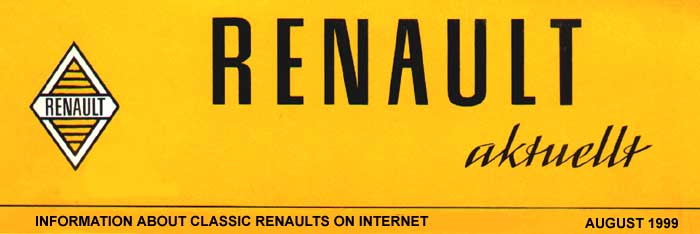
Information about Swedish car owning
License plates Registration numbers Headlights in daylight Old cars Swedish winters Drivers license
LICENSE PLATES
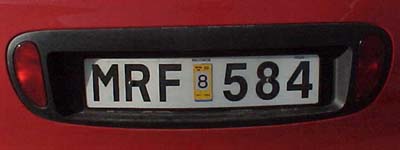
Swedish license plate of the latest design (from 1994)
Do you know the meaning of the coloured sticker on the rear license plate on all Swedish cars?
The sticker is the motor vehicle tax recceipt and it is also a sign that the car was approved in the annual inspection.
The inspection is a test made to all cars older than four years to check that the car is road worthy.
This test is made by a public organisation called Svensk Bilprovning and covers brakes, lights, emissions, chassie and tires.
If there is any faults found you have one month to repair it and then you have to come back and do the test again.
The sticker has a different color every year and this way it is easy for the police to spot cars that has not been approved in the annual test or has not payed the road tax.
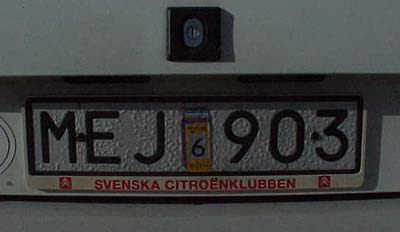
Swedish license plate made in plastic earlier design (from 1985)
the typical bubbles in the surface came with time.
REGISTRATION NUMBERS
A Swedish car keeps the same registration number througout its life
A car in Sweden gets a registration number when it is registrated for the first time, the car keeps this number until it is scrapped after that the number is reused to a new car.
It is just the road safety department that can make registration plates and in order to get new plates you have to return the old ones.
There has been four types of license plates in sweden during the last 50 years, the first type was a nonreflective aluminium type with plastic or metal numbers, the registration number consisted of a landscape code letter and a number (N 1753 for a car from Halland)
This design was replaced in 1973 by a reflective registration plate and a new registration number type with three letters and three numbers (GDO 759) all old registration plates was replaced during one year.
The new registration plates was made in aluminum with the registration number pressed in relief,you can see this type of plate on my Renault 17 below.
In 1985 came a new design in plastic, this plate was only used on new cars and the old plates was not replaced.
After just a few months there were huge problems with the new registration plates the white reflective coating started to "bubble" and fall off when it was exposed to sunlight, theese problems where solved after a few months but during that time several cars drove around with completly black plates.
The latest type of registration plates came in 1994 this is a plastic plate with a flush surface, the registration number has been completed with registration date and chassie number in smaller text.
This plates comes on new cars and if you order new registration plates the older types of plates are still valid.
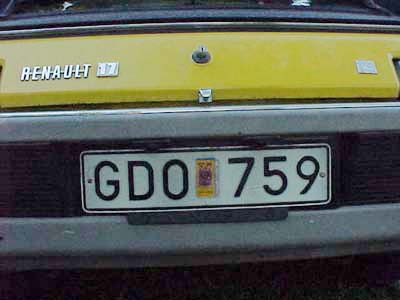
Swedish license plate made in aluminium (from 1975).
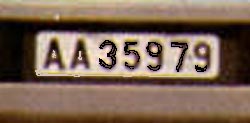
The earliest type of license plate, nonreflective aluminium.
HEADLIGHTS DURING DAYLIGHT
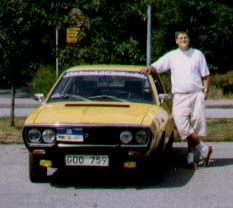
My car fitted with "premonitory lights" (on both sides of the license plate)
Why does all cars in Sweden have the headlights on in daylight?
There is a law in Sweden demanding the use of headlights eaven in daytime.
This demand came about 1977 and you had the choice to use the headlights all the time or install "premonitor lights" this was very common back then, nowadays all new cars is equipped with automatic headlights that goes on when you start the engine.
In 1975 was another law added it stated that all new vehicles should have headlight wipers, this made that all Renault 17 1975 sold in Sweden had Renault 15 lights with wipers.
Other Swedish special demands was mudflaps on all wheels, external mirror on both left and right side and on Renault 15/17 a Special safety padding on the screens over the speedometer.
THE SWEDES CARS ARE OLD
In Sweden 55% of the cars are older than 10 years.
In Sweden 55% of the cars are older than 10 years, the figure for France is 31% and Germany 27%.
Only Greece and Albania has a larger percentage of old cars in Europe.
The average life length of cars in Sweden is 17 years, almost every day you can see 40 years old Volvo Pv in utility trafic.
The most common old French cars in utility use is Renault 4 , Renault 5 and CitroŽn 2cv from the early seventies, you can also see some old Peugeots mostly diesel 504 and 404.
In Sweden we have 9 cars / square mile the correspanding figure for Belgium is 161 and for Germany 121.
THE SWEDISH CLIMATE
The winter in Sweden is so cold that you need to use grille covers.
During the Swedish winter temperatures below -20c is not uncommon.
In order to keep the engine heat up You have to use some kind of grille cover during winter.
As a matter of fact most French cars sold in Sweden during the seventies
and eighties was sold with a cover for the grille,
it was often made of vinylfabric or plastic.
According to the manual of my R17TS the cover should be attached at
temperatures below 0C , and if it was colder than -10C you should close the
two flaps that that sealed the grille compleatly.
My new Scenic was not delivered with any grille covers, but it keeps the
temperature any way.
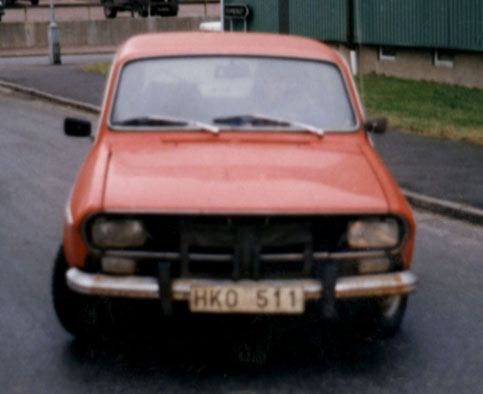
This picture is not to sharp, but it shows my R12TN -75 with open grille cover.
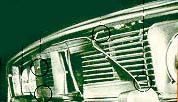
This is picture shows how to attach the grille cover on a Renault 17.
DRIVERS LICENSE
In Sweden you have to be 18 years old before you can get a drivers license.
But you can start practise driving when you are 16 years old.
The drivers license might be recalled if you are speeding, drunk driving or drives wreckless.
The speed limits in Sweden is 30km/h at schools 50km/h in cities 70km/h on major roads 90km/h outside cities and 110km/h on motorways.